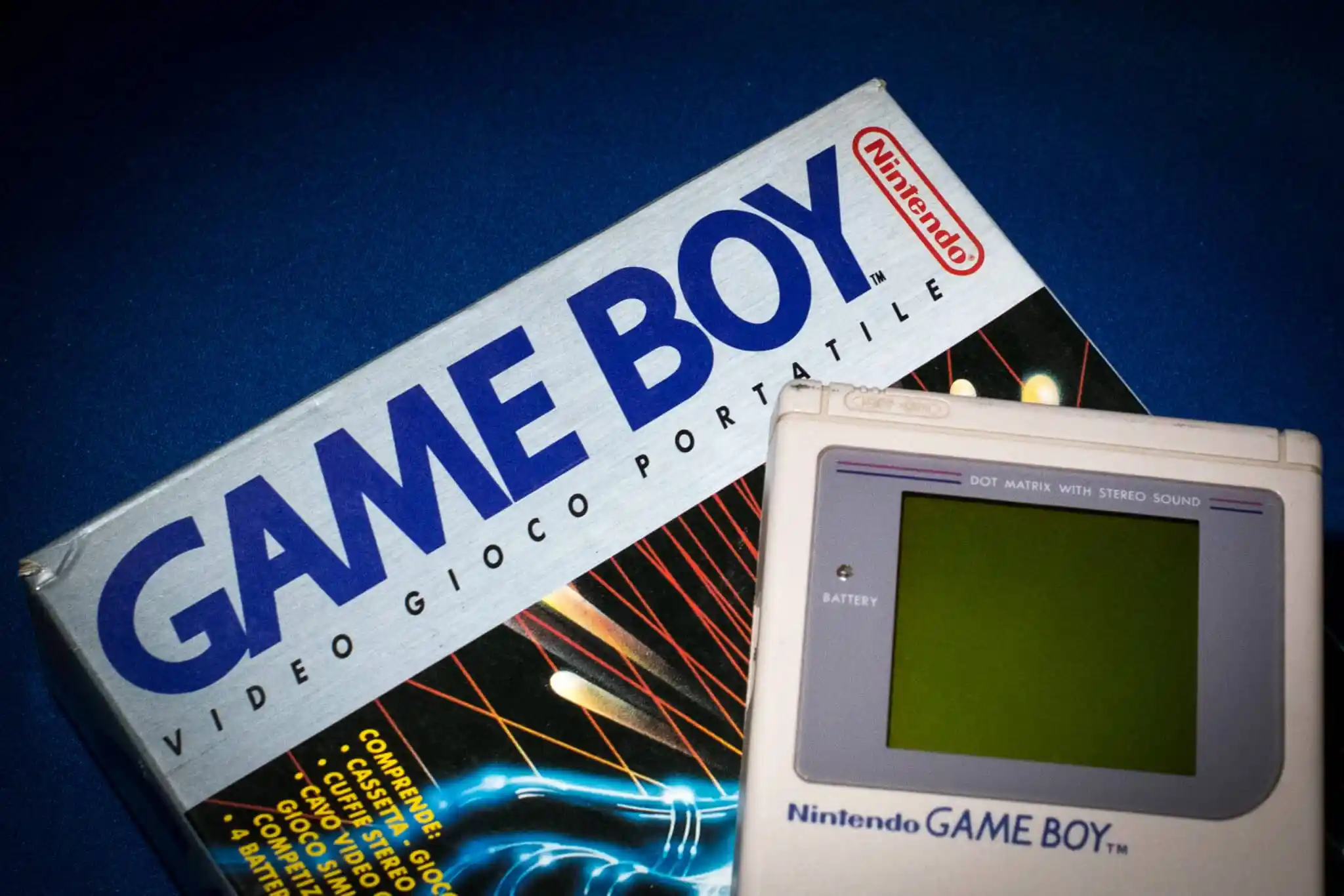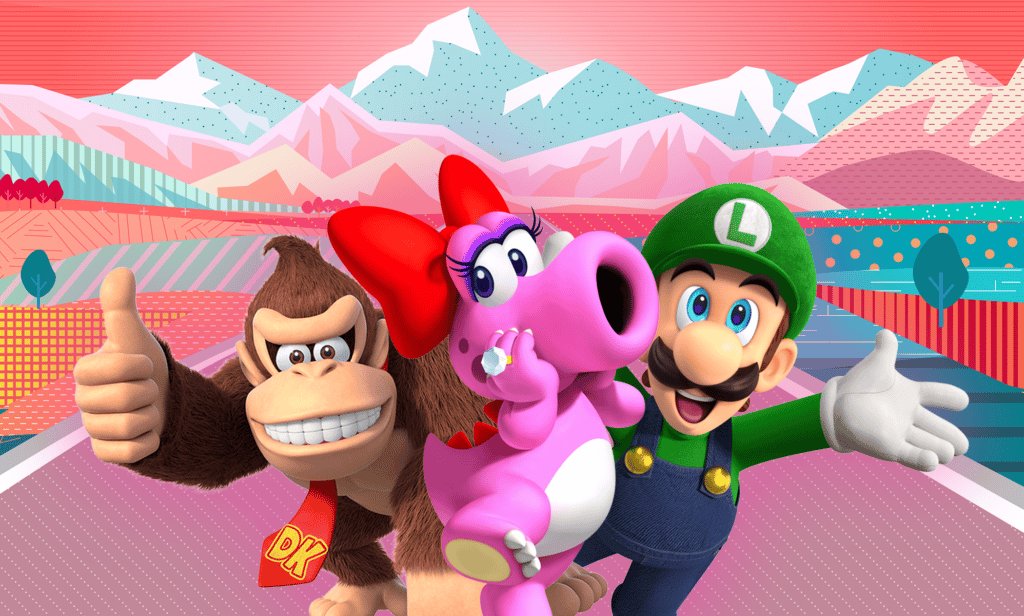Nintendo says LGBTQ+ rights. (Nintendo/PinkNews)
From direct representation to fan-made trans mascots, gaming publisher Nintendo has a strangely compelling history with LGBTQ+ representation.
As one of the most prominent video game companies in the world, it’s no surprise that today Nintendo encompasses a plethora of LGBTQ+ voices.
But its history with queer representation dates back further than you may think.
The first queer Nintendo character debuted in 1988 in the Nintendo Entertainment System (NES) game Super Mario Bros 2: recurring boss Birdo.
Birdo had been designed for the game Yume Kōjō: Doki Doki Panic but went unused. Along with many other assets and characters, she was eventually transformed for the Mario brothers’ second main title.
Her description in the North American instruction booklet seems to suggest she is transgender. An explanation, which has aged like milk, read: “He thinks he is a girl and he spits eggs from his mouth. He’d rather be called ‘Birdetta’.” Certain translations of her original description in Doki Doki Panic also suggest she likes the name “Cathie’.”
This makes Birdo – who continued to use that name and she/her pronouns in future promotional material – the first transgender character in gaming history.
What’s more, her gender ambiguity hasn’t been swept under the rug.

Birdo’s validity in her gender identity is seemingly acknowledged by the entire gang. In Mario Kart 8, she appears alongside Princess Peach and Princess Daisy in “Women of Racing Organisation” advertisements and in Mario Golf: Toadstool Tour she is categorised as a female golfer.
There have been occasional transphobic undertones around Birdo, such as a section in the instructions of Super Mario Strikers that reads: “Birdo is your man… well, or woman.”
But cringeworthy attempts at humour aside, Birdo’s legacy gave way to the introduction of more LGBTQ+ characters in Nintendo franchises such as Metroid, Animal Crossing, and Pokémon.
Nintendo and LGBTQ+ rights in Japan
Arguably, a lot of Nintendo’s early queer characters are the roundabout outcome of Japan’s poor history on LGBTQ+ rights.
Nintendo has always thrived on what is considered strange and unordinary at any given time. Unfortunately, LGBTQ+ identities were incredibly stigmatised in 1980s Japan, when Birdo was introduced, and the community is still, even today, fighting for basic legal rights like same-sex marriage and protections from discrimination.
.The gaming company could have seen incorporating an LGBTQ+ character as a way to, at the time, signify its lightheartedly strange brand image.
In modern times, Nintendo has embraced the LGBTQ+ community. In July, after a court in Osaka (where Nintendo is baed) upheld the Japanese ban on same-sex marriage, the company introduced a policy giving employees in same-sex relationships equal standing.
That willingness to embrace change is a huge reason why the gaming behemoth today has such a diverse and predominantly accepting community.
It’s also the reason why games such as Animal Crossing are seen as a safe space for the LGBTQ+ community, especially during the height of the COVID-19 pandemic. It’s not so much that the company specifically tailors its experiences toward specific groups, but that it opens its arms toward anyone and everyone.
Trans Luigi and Donkey Kong the ally
This unrestrictive openness also lends itself well to the way it portrays its characters, especially in the Mario universe. Mario and friends don’t have specific storylines or character arcs but are simply mascots with generalised archetypes that can be put into any product Nintendo desires. It also means they are ripe for fan theories.
Take Luigi for example. Nintendo’s official description reads: “He may not always be the centre of the action, but when Mario needs him, Luigi jumps right into harm’s way.” This surface-level ambiguity and a few morsels of evidence have led fans to theorise the character is queer.
The theory originally began after the 2019 release of New Super Mario Bros Deluxe for the Nintendo Switch. The game introduced a new power-up called the Super Crown which transformed the character Toadette into an upgraded form that looks exactly like Princess Peach, known as Peachette.
While only available when playing as Toadette, fans started to wonder what would happen if other characters managed to acquire the new power-up. This resulted in a joke fan character in which Bowser used the crown to become Bowsette.
Nintendo joined in with the joke and updated the item description on its website to read: “When Toadette finds one of these, she can transform into the super-powered Peachette. (Sorry Luigi – only Toadette can use this item!)”
Fans immediately started using #TransLuigi in an effort to acknowledge the validity of the queen herself. Users also pointed out how the character’s history with gender roles supports the claim, including a comic strip where Luigi steals Peach’s dress, saying: “I don’t know… I’m beginning to like it.”
She’s OURS now pic.twitter.com/DYnXrrsFgE
— Michaela Joffe (@joffeorama) January 5, 2019
Your reminder that Luigi is trans#transluigi #transluigi pic.twitter.com/O7hVPimtVz
— Jenny the Miney Gal (@megaminerjenny) February 6, 2020
The trans Luigi saga encompasses just a small microcosm of the wonderfully weird and captivating ways the Nintendo fandom has incorporated LGBTQ+ identities into the series, even without the company’s direct participation.
Another example includes a wonderful story of how fans declared Donkey Kong as the ultimate trans ally after YouTuber and streamer Harry Brewis AKA Hbomberguy raised $347,000 for the UK trans charity Mermaids by playing the 1999 platformer Donkey Kong 64 for 57 hours.
The streamer received acknowledgements from various celebrities and trans activists, including US congresswoman Alexandria Ocasio-Cortez, trans whistleblower Chelsea Manning, and American actress Mara Wilson.
In a 2019 interview with PinkNews, Brewis said he was shocked after the stream went viral and reached a peak of 25,000 concurrent viewers during its live broadcast.
“I actually broke down and cried a little bit about $75,000 in,” Brewis continued. “I’d really expected it to not do very well. Because I didn’t think that many people really knew or cared [about trans issues]. I thought that was part of the territory and that’s why it’s worth doing.
“I think what caused so many people to react the way they did was the utter shock at discovering that there are so many who are willing to help, so many people who care, and they were almost waiting for an excuse to do it.”
Of course, no company is perfect. Nintendo certainly hasn’t been the one and only LGBTQ+ gaming safe haven and things like its fan game policy can often feel like the company is trying to quash creative freedom, but if for nothing else, it has fostered an environment where people can be who they wish to be, and find themselves in the worlds Nintendo has created.
